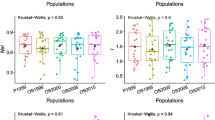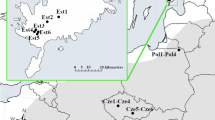Abstract
The degree of intraspecific genetic polymorphism and heterozygosity, the germinal death, viability of seeds, and the cytogenetic state of vegetative Ulmus pumila and U. suberosa meristems were analyzed for determining the mechanisms of plant population invasiveness in the steppe Dnieper region under climate changes. The studied U. pumila population were different in terms of germinal (embryonic) death, seed viability and seed productivity. Populations grown under more favorable environmental conditions had the best reproductive, physiological and genetic conditions. For the majority of used microsatellite loci, population studies were characterized by a relatively low level of genetic variability, an excess of homozygous genotypes and a deficiency of heterozygotes, which indicated a certain level of inbreeding of the analyzed plants. The highest deficiency of heterozygotes was found in U. pumila populations with high stand density and significant indices of germinal seed loss; smaller deficits were in populations with a larger area and low stand density and, accordingly, low rates of germinal death. The low index of chromosomal rearrangements in the vegetative meristems also confirmed an insignificant level of genetic variability and the probable absence of hybridization and genetic homeostasis in U. pumila. The U. suberosa population was characterized by increased indices of germinal death, seed damage and low seed productivity, which correlated with an excess of homozygous genotypes. All U. suberosa specimens were monomorphic by the microsatellite loci. In general, by genetic and reproductive indices, seed reproduction and distribution of U. pumila in the steppe Dnieper region is not significantly limited under climate change. At the same time, seed reproduction of U. suberosa may be limited.






Similar content being viewed by others
REFERENCES
Forrest, J. and Miller-Rushing, A.J., Toward a synthetic understanding of the role of phenology in ecology and evolution, Phil. Trans. R. Soc. Lond. B Biol. Sci., 2010, vol. 365, no. 1555, pp. 3101–3112. https://doi.org/10.1098/rstb.2010.0145
Lurgi, M., Wells, K., Kennedy, M., Campbell, S., and Fordham, D.A., A Landscape approach to invasive species management, PLoS One, 2016, vol. 11, no. 7, pp. 1–20. https://doi.org/10.1371/journal.pone.0160417
Lopez-Almansa, J.C., Review. Reproductive ecology of riparian elms, Invest. Agrar.: Sist. Recur. For., 2004, vol. 13, no. 1, pp. 17–27.
Lopez-Almansa, J.C., Yeung, E.C., and Gil, L., Abortive seed development in Ulmus minor Mill. (Ulmaceae), Bot. J. Linn. Soc., 2004, vol. 145, no. 4, pp. 455–467.https://doi.org/10.1111/j.1095-8339.2004
Streng, D.R., Glitzenstein, J.S., and Harcombe, P.A., Woody seedling dynamics in an east Texas floodplain, Ecol. Monogr., 1989, vol. 59, pp. 177–204.
Perea, R., Venturas, M., and Gil, L., Empty seeds are not always bad: simultaneous effect of seed emptiness and masting on animal seed predation, PLoS One, 2013, vol. 8, no. 6, pp. 1–9. https://doi.org/10.1371/journal.pone.0065573
Sakai, A.K., Allendorf, F.W., Holt, J.S., Lodge, D.M., Molofsky, J., With, K.A., Baughman, S., Cabin, R.J., Cohen, J.E., Ellstrand, N.C., McCauley, D.E., O’Neil, P., Parker, I.M., Thompson, J.N., and Weller, S.G., The population biology of invasive species, Annu. Rev. Ecol. Syst., 2001, vol. 32, pp. 305–332. https://doi.org/10.1146/annurev.ecolsys.32.081501.114037
Zalapa, J.E., Brunet, J., and Guries, R.P., The extent of hybridization and its impact on the genetic diversity and population structure of an invasive tree, Ulmus pumila (Ulmaceae), Evol. Appl., 2010, vol. 3, no. 2, pp. 157–68. https://doi.org/10.1111/j.1752-4571.2009.00106.x
Lopez-Almansa, J.C. and Gil, L., Empty samara and parthenocarpy in Ulmus minor s. l., Silvae Genet., 2003, vol. 52, pp. 241–243.
Venturas, M., Fuentes-Utrilla, P., Ennos, R., Collada, C., and Gil, L., Human induced changes on fine-scale genetic structure in Ulmus laevis Pallas wetland forests at its SW distribution limit, Plant Ecol., 2013, vol. 214, no. 2, pp. 317–327.https://doi.org/10.1007/s11258-013-0170-5
Santamour, F.S.Jr. and Ware, G.H., Chromosome numbers of new Ulmus (elm) taxa introduced from China. Rhodora, 1997, vol. 99, pp. 148–151.
Chromosome Numbers of Flowering Plants (Directory), Leningrad: Science, Leningrad Sep., 1969.
Hirsch, H., Brunet, J., Zalapa, J.E., and von Wehrden, H., Intra- and interspecific hybridization in invasive Siberian elm, Biol. Invasions, 2017, vol. 19, no. 6, pp. 1889–1904. https://doi.org/10.1007/s10530-017-1404-6
Sambrook, J. and David, W.R., Molecular Cloning: A Laboratory Manual, New York: Cold Spring Harbor, 2001.
Zalapa, J.E., Brunet, J., and Guries, R.P., Patterns of hybridization and introgression between invasive Ulmus pumila (Ulmaceae) and native U. rubra,Am. J. Bot., 2009, vol. 96, no. 6, pp. 1116–1128. https://doi.org/10.3732/ajb.0800334
Zalapa, J.E., Brunet, J., and Guries, R.P., Isolation and characterization of microsatellite markers for red elm (Ulmus rubra Muhl.) and cross-species amplification with Siberian elm (Ulmus pumila L.), Mol. Ecol. Resour., 2008, no. 8, pp. 109–112. https://doi.org/10.1111/j.1471-8286.2007.01805.x
Lazar, I., GelAnalyzer.com [homepage on the Internet], 2010. http://www.gelanalyzer.com/.
Kelly, D. and Sork, V., Mast seeding in perennial plants: why, how, where?, Ann. Rev. Ecol. Syst., 2002, vol. 33, pp. 427–447. https://doi.org/10.1146/annurev.ecolsys.33.020602.095433
Oficerov, M.V. and Igonina, E.V., Genetic nonsequences radiation exposure of the Scots pine (Pinus sylvestris L.), Genetics, 2009, vol. 45, no. 2, pp. 209–214.
Bob, C.F., Redmond, B.L., and Karnosky, D.F., on the nature of intra-and interspecific incompatibility in Ulmus,Am. J. Bot., 1986, vol. 73, no. 4, pp. 465–474.
Santamour, F.S., Jr. A natural hybrid between American and Siberian elms (Ulmus americana, Ulmus pumila), Forest Sci., 1970, vol. 16, pp. 149–153.
Elowsky, C.G., Jordon-Thaden, I.E., and Kaul, R.B., A morphological analysis of a hybrid swarm of native Ulmus rubra Muhl. and introduced U. pumila L. (Ulmaceae) in southeastern Nebraska, Phytoneuron, 2013, vol. 44, pp. 1–23.
Silvertown, J.W., The evolutionary ecology of mast seeding in trees, Biol. J. Linn. Soc., 1980, vol. 14, pp. 235–250.
Bozhkov, P.V., Filonova, L.H., and Suarez, M.F., Programmed cell death in plant embryogenesis, Curr. Top. Dev. Biol., 2005, vol. 67, pp. 135–179.
Filonova, L.H., von Arnold, S., Daniel, G., and Bozhkov, P.V., Programmed cell death eliminates all but one embryo in a polyembryonic plant seed, Cell Death Diff., 2002, vol. 9, no. 10, pp. 1057–1062.
Zalapa, J.E., Brunet, J., and Guries, R.P., Genetic diversity and relationships among Dutchelm disease tolerant Ulmus pumila L. accessions from China, Genome, 2008b, no. 51, pp. 492–500. https://doi.org/10.1139/G08-034
Zalapa, J.E., Brunet, J., and Guries, R.P., Isolation and characterization of microsatellite markers for red elm (Ulmus rubra Muhl.) and cross-species amplification with Siberian elm (Ulmus pumila L.), Mol. Ecol., 2008, no. 8, pp. 109–112.
Pirko, Ya.V., Kalafat, L.O., Pirko, N.M., Rabokon, A.N., Privalikhin, S.N., Demkovych, A.Ye., Bilonozhko, Yu.O., Kravets, O.A., Alexeyeva, A.A., Khromykh, N.O., and Lykholat, Yu.V., Intron length polymorphism of β-tubulin genes in Ulmus pumila L. plants in the Steppe Prydniprov’yia, Visn. Ukr. Tovar. Genet. Selekts., 2018, vol. 16, no. 1, pp. 28–34.
Nielsen, L.R. and Kjr, E.D., Gene flow and mating patterns in individuals of Wych elm (Ulmus glabra) in forest and open land after the influence of Dutch elm disease, Conserv. Genet., 2010, no. 11, pp. 257–268.
Funding
The publication contains the results of research conducted with the grant support of the State Fund for Basic Research for the project (F76/39- 2018).
Author information
Authors and Affiliations
Corresponding authors
Ethics declarations
The authors declare that they have no conflict of interest. This article does not contain any studies involving animals or human participants performed by any of the authors.
Additional information
Translated by V. Mittova
About this article
Cite this article
Kravets, O.A., Pirko, Y.V., Kalafat, L.O. et al. Genetic and Reproductive State Assessment of Ulmus pumila and U. suberosa Invasive Populations in the Dnieper Steppe under Climate Change. Cytol. Genet. 54, 1–9 (2020). https://doi.org/10.3103/S0095452720010090
Received:
Revised:
Accepted:
Published:
Issue Date:
DOI: https://doi.org/10.3103/S0095452720010090




